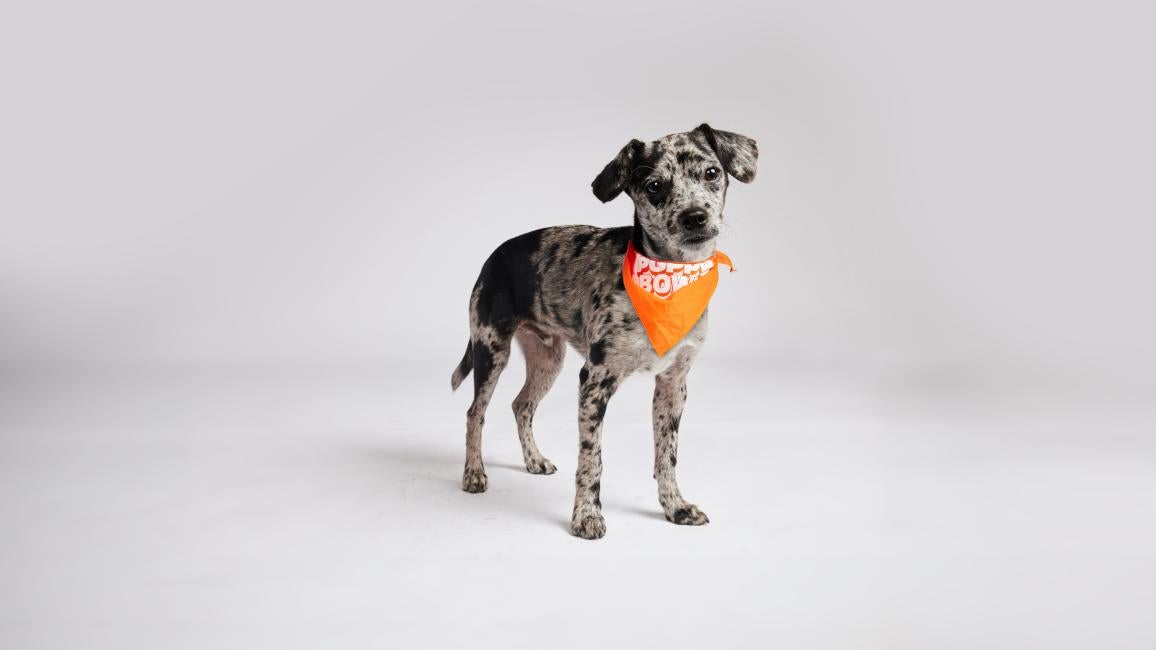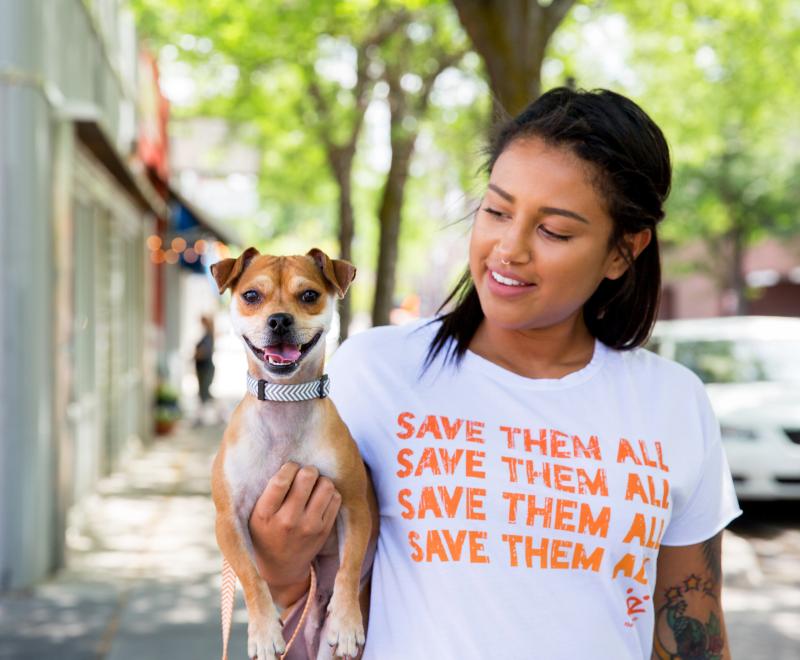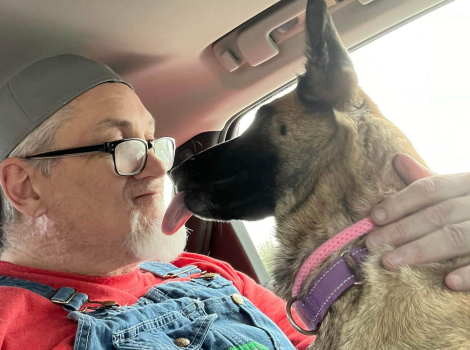A puppy’s journey part 1: A star is born

This is part 1 of a three-part series about Sonny. Read part 2. Read part 3.
You just can’t help but fall in love with Sonny. Maybe it’s his speckles and dots. Maybe it’s his cool and curious greeting — like he has plenty of friends already, but he’ll add you to his circle if you’re kind. He’s not much larger than a cat, and he hasn’t even been on this Earth for a full year yet. But Sonny has seen a lot.
His life so far has either been extraordinary or totally ordinary depending on how you look at it. But let’s start at the beginning on a road in rural Alabama. Because that’s where Sonny’s story begins.

Stray puppies
How do two tiny puppies end up alone outdoors in a rural area with no mama dog or human responsible for them in sight? We will likely never know. They could have wandered away from their yard, or maybe someone dropped them off to fend for themselves in hopes that a kind soul would find them and take them in. But whatever happened to them during the first few weeks of their lives ultimately led to them bumbling around — as puppies do — by themselves on a road in Elmore County, Alabama, on a warm July day.
Someone spotted the wiggly pups alongside the road. One was a speckled and spotted black, gray, and white little guy, and his sister was a pretty cream color. The concerned person who noticed the puppies scooped them up and brought them to the Humane Society of Elmore County.
“That happens almost daily here,” says Rea Cord, executive director at the shelter. “It’s sad, and I wish it wasn’t like this, but we get puppies — and kittens, of course we’re all buried in them — six days a week.” She’s quick to say that there are many wonderful people in her community and throughout the South who spay or neuter and take excellent care of their pets. But even so, there are still too many folks with dogs and cats having litters, and many of them end up in shelters. “Last year we took in 808 puppies and 1,162 adult dogs. So a large percentage of the dogs we take in are under 6 months old.”
Presented with the little pair of pups, a staff person took them and examined them to find that they were some of the lucky ones. They were a bit skinny, full of worms, and needed vaccines, but they were otherwise OK. Neither was injured, and they hadn’t been out long enough to become dehydrated or starved.
[What to Expect With a New Puppy]
Their information went into the shelter’s database, marked as “stray” in case anyone came looking for them. In the meantime, it would help to call them something other than “stray puppy one” and “stray puppy two.” That’s how Sonny got his name (and his sister became known as Cher).
The next step was to get them out of the shelter as quickly as possible. “In an open-admission shelter like ours, the more puppies you have, the greater the disease risk,” says Rea. “Puppies come in with no vaccine history, and you can only have so many in your shelter before you end up with a disease outbreak.”
That’s where Lorri and Fred Simpson came in.
“They foster the majority of our puppies; they just have a heart for it,” Rea says. Sonny and Cher were soon on their way to Lorri and Fred’s house. This fateful day was the first step on an unexpected path to Sonny becoming a star.

Foster home for wayward puppies
Lorri is a part-time employee at the shelter in Elmore County, but she describes her main role as “puppy mama.” Sonny arrived at her house to join foster puppies who came to the shelter before him — and those who would come after him. There are always more who need Lorri.
Sonny and his sister got a clean space with beds and toys, water and food, separate from other pups at first to ensure that if they did have any contagious conditions, they wouldn’t spread them to others.
Meanwhile, Lorri got to work on the truly endless daily cleaning, feeding, and cuddling that comes with fostering puppies. Is it a lot of work? Yes.
“Sometimes it’s overwhelming, and I ask myself why we do this,” Lorri says. But then she gets a photo or a video from someone who adopted a puppy she fostered. Like the one of a little girl playing with her new puppy; her mom shared that the two are best friends and are never apart from one another. The girl’s mom shared that they’d lost their dog to cancer, and her daughter had lost the sparkle in her eye ever since. Now she’s happy again.
“That’s why I do what I do,” Lorri says. “You think you’re just making a difference in the life of this one puppy, even if he’s in a litter of 10. But you don’t know the ripple effect of who ends up with that baby down the road and their story — how it touches and changes their lives.”
Lorri and Fred’s house is beautiful, pet-filled, organized chaos. They have a spacious home on three acres, and it is home to all kinds of animals — some foster pets and some permanent residents.
“We’ve never been blessed with biological children ourselves, but I fostered children in Tampa for years from inner city projects,” Lorri says. Her house is always filled with pets, family members, nieces, and nephews, all which makes for well-socialized puppies, too. That would turn out to be a key part of Sonny’s future.
Sonny and his sister were relatively easy guests and loved running and playing in the backyard. Then they’d come in and crash into a nap or climb the pet steps to lounge on the couch.
Life was good. No one ever claimed the stray puppies, but they thrived in Lorri’s home. They learned about life from her adult dogs, and there were always friendly new people for them to meet.
But the plan wasn’t for them to stay at Lorri’s house forever.

Southern pups head north to homes
Once their stray hold period was over, Rea began planning a way to get Sonny and Cher into homes. The best option, she determined, would be to send them on the monthly trip up north. That’s when Best Friends sends a van from New York down south to pick up puppies and kittens, dogs and cats to place in homes ourselves or to deliver to other partners.
While shelters like Elmore County are inundated with puppies year-round, that’s not the case up north. There, it’s more likely for shelters to have waiting lists of people who want puppies, with hardly any coming in from the local community. Sending many of the puppies who come into her shelter north for adoption not only gets them into homes more quickly, Rea says, but it also “helps immensely when there’s still so many more puppies who need help here. Sending these pups also helps open space for the larger adult dogs who are our most challenging to find homes for.”
[Why Adopt a Pet Instead of Buy?]
That’s how one day in September, Sonny, Cher, and many other pets from Elmore County, Alabama, came to be tucked into travel crates for a long journey to New York City.
It can be hard for Lorri to say goodbye to the puppies she’s poured so much love and care and attention into. But there are always more who need her, and the updates from her former foster puppies as they go into new homes make it all worthwhile.
You just never know how a puppy’s life will turn out. When little Sonny left Alabama, he was just 4 months old. The hum of the tires on the interstate lulled him to sleep as he came closer to his final destination: New York City.
Let's make every shelter and every community no-kill by 2025
Our goal at Best Friends is to support all animal shelters in the U.S. in reaching no-kill by 2025. No-kill means saving every dog and cat in a shelter who can be saved, accounting for community safety and good quality of life for pets.
Shelter staff can’t do it alone. Saving animals in shelters is everyone’s responsibility, and it takes support and participation from the community. No-kill is possible when we work together thoughtfully, honestly, and collaboratively.







